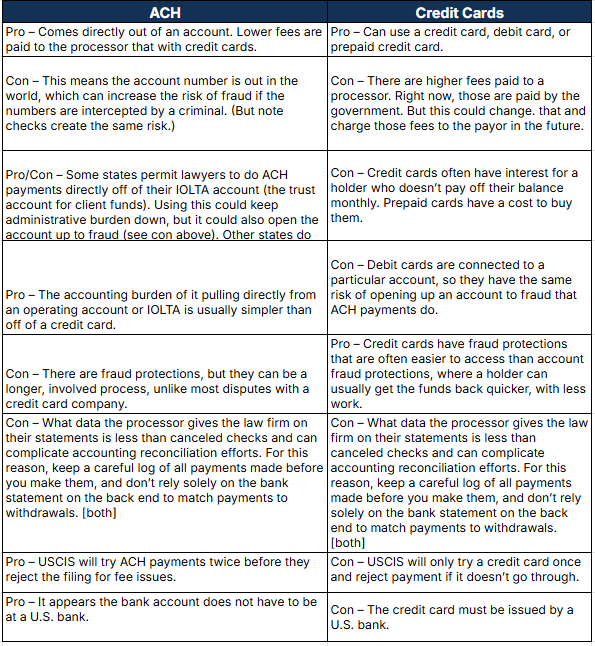Avoid Rejections: USCIS Adopts Electronic-Only Fee Payments
Effective October 28, 2025, USCIS will no longer accept paper checks or money orders for filing fees payments. This is due to Executive Order 14247, Modernizing Payments to and from America’s Bank Account. This order aims to move away from paper-based payments in favor of secure electronic methods to the risks of fraud, lost payments, and theft.
Restrictions and Details:
Starting October 28, 2025, USCIS will only accept ACH payments (using Form G-1650) or Credit Card payments (using Form G-1450).
If paying via Form G-1650, the ACH payment must come from a U.S. bank account. For ACH payments, ensure the bank account has sufficient funds, and the account does not have a debit block for USCIS ACH withdrawals. If the transaction is declined, USCIS may reject the entire filing. If applicants do not have a U.S. bank account, you may pay with a credit or debit card using Form G-1450.
Acceptable card networks are Visa, MasterCard, American Express, Discover, and prepaid cards from the same card networks. Gift cards and cards issued by foreign banks are not acceptable. There is no additional cost if paying with a credit or debit card.
Make sure the card’s credit limit can cover the fee. USCIS will reject your application, petition, or request if the card is declined, and will not attempt to process your credit card payment a second time.
When submitting multiple applications at once, pay each fee separately using a single method (ACH or card) per application. Combining payment for multiple applications may lead to USCIS rejecting your application.

Why This Matters
This change is not just a procedural update. It underscores a broader shift in federal payment policy. Executive Order 14247 emphasizes that paper checks impose “unnecessary costs; delays; and risks of fraud, lost payments, and theft” for the U.S. Treasury.
Agencies are required to move toward electronic funds transfer (EFT), credit/debit card, digital wallets, and other modern payment systems. For those filing with USCIS, this means you must be prepared: if you send a paper check after the cutoff date, your filing runs a significant risk of being rejected for improper payment.
Only you can make this decision, but there are pros and cons to consider with both payment options.

What You Should Do
Review the specific form or petition you’re going to file and identify the correct fee amount. If you are submitting multiple filings at once, make sure each one is accompanied by its own payment method and fee, do not combine into one payment.
If paying via G-1650 with an U.S. bank account, set up ahead of time. If paying via G-1450, verify your card’s credit limit or available balance covers the full fee amount. Maintain record of your payment for your reference.
Avoid scanned signatures that are unclear or appear not to align with USCIS wet-ink signature policy. It is best practice to submit these forms with a wet signature to avoid a rejection, but a clear scan of a wet signature may also be acceptable.
Conclusion:
Plan now to ensure your payment method will be accepted when filing with USCIS. Electronic payment readiness will help prevent unnecessary delays, rejections, or missed deadlines. If any part of your payment process is unclear, address those questions ahead of time to avoid complications.
Do not mail in a check or money order for filings dated on or after October 28, 2025. The payment method will not be accepted under the new rules. Ensure that the account or card used is authorized, valid, and has funds to cover the payment amounts. Note that USCIS may reject your application if the transaction is denied.
If you have any questions regarding these changes, please email PSBP Partner, Chris Prescott at cprescott@psbplaw.com